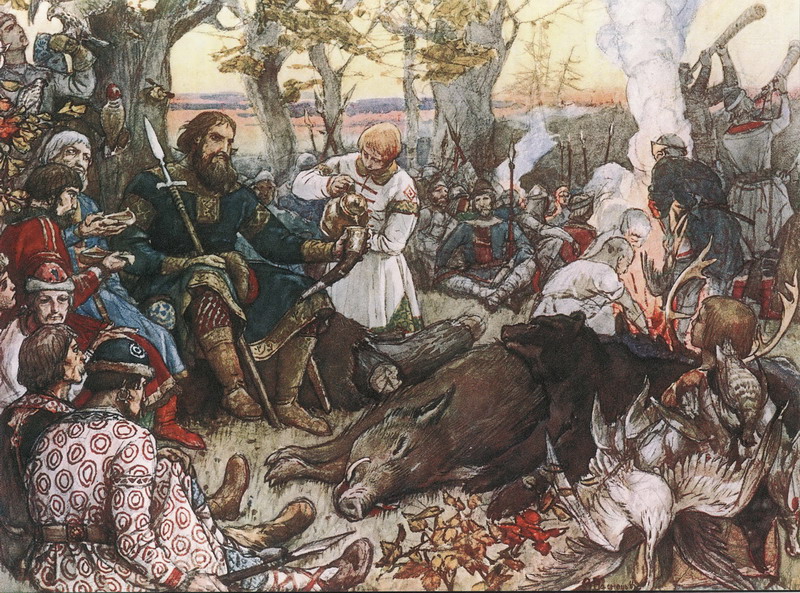12th Century
Vladimir Monomakh and the founding of Vladimir
In 1108 the city of Vladimir on the River Klyazma in north-eastern Rus was first mentioned in Russian chronicles. The city was founded by Vladimir Monomakh supposedly on the site where St Vladimir once camped out in the 9th century while on a mission to convert the pagans of North-Eastern Rus to Orthodoxy. The new city was therefore named in honour of the two Vladimirs. Upon the death of Grand Prince Svyatopolk II in 1113 Vladimir Monomakh, already the most prominent of the Ryurikid princes of the time, finally became grand prince. This was done in breach of the proper order of succession as more senior cousins were still alive, but the citizens of Kiev protested after Svyatopolk II’s death and demanded that the throne be given to Vladimir Monomakh, who was popular due to his victorious campaigns against the Polovtsians. In all Monomakh and his sons controlled around three-quarters of Rus lands, and this period has been called a Golden Age of Kievan Rus, thanks to the wise governance and military skill of Vladimir Monomakh.
Mstislav the Great
Vladimir Monomakh was such a strong and respected leader that when he died in 1125 he was able to pass the Kievan throne to his son Mstislav, ignoring his more senior cousins - the children of Svyatopolk II, who were still powerless to ignore the violation of their more legitimate rights to the throne over Monomakh and now his sons. The fact that Monomakh bought Mstislav from Novgorod to neigbouring Bilgorod-Kievsky to act as a sort of co-ruler obviously helped this transition. Mstislav reigned in the same manner as his father and even became known as Mstislav the Great. His greatness was hinted at during his reign in Novgorod which is notable for its length as Novgorod’s nobles were famed for disposing of princes who displeased them. Mstislav left his mark in Novgorod in the form of St Nicholas' Cathedral, which still survives today. Like his father before him, Mstislav saw the importance of installing his sons in the various Rus principalities and under his sons he controlled Novgorod, Kursk and Smolensk. He even managed to capture the Polotsk principalities and exiled the original Polotsk princes to Constantinople in 1130. Mstislav’s daughters were married off to the Danish, Norwegian and Byzantine royalty, as well as to the Rus princes of Novgorod-Seversky and Volynia.
Yaropolk II, the Monomakhovichy, the Mstislavichy and the Olgovichy
Mstislav died peacefully in 1132 and was succeeded by his brother Yaropolk Vladimirovich (Yaropolk II). The strength of character of both Vladimir Monomakh and Mstislav the Great held the majority of the Rus principalities together and both of their reigns saw unprecedented times of peace in Kievan Rus. However the death of Mstislav would end all this as the various princes saw the chance to act upon their grievances regarding violations of the line of succession. There were three main factions which Yaropolk II had to deal with, his younger brothers known as the Monomakhovichy, his nephews the sons of Mstislav the Great known as the Mstislavichy and the sons of Oleg Goreslavich known as the Olgovichy.
Struggle for Pereyaslavl
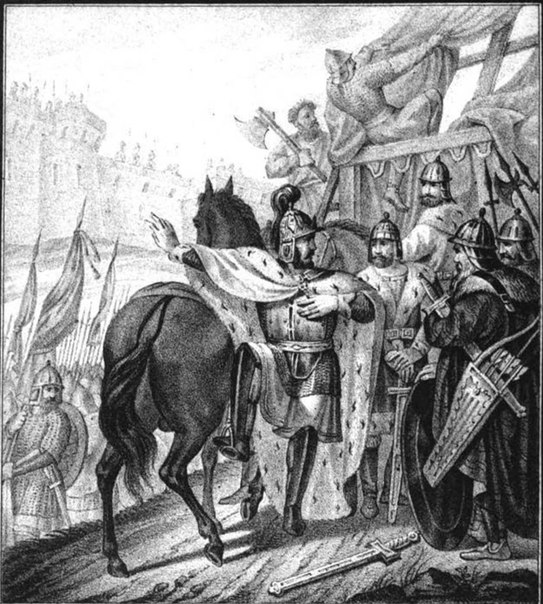
The first challenge came immediately when Yaropolk II gave Prince Izyaslav Mstislavich of Polotsk (son of Mstislav the Great) the Pereyaslavl Principality, which was traditionally considered the patrimony of the Monomakhovichy. The most active Monomakhovichy - Yuri Vladimirovich of Rostov-Suzdal, who is known as Yuri Dolgoruky (Yuri the Long-Arms) due to his meddling in Kiev from his far away province of Rostov-Suzdal - saw this as an affront to him. He also considered it an attempt by his brother to disinherit the younger Monomakhovichy brothers in favour of the children of Mstislav the Great. Yuri Dolgoruky led a campaign against Pereyaslavl and drove out Izyaslav Mstislavich. During this period the former Polotsk princes were able to regain their former principality, vacated by Izyaslav Mstislavich. Yaropolk II made his young brother Prince Vyacheslav Vladimirovich of Turov prince of Pereyaslavl, but less than two years later in 1134 Vyacheslav left Pereyaslavl and returned to his former, more tranquil, principality of Turov. Yaropolk II then made another attempt to make a son of Mstislav the Great prince of Pereyaslavl installing Prince Vsevolod Mstislavich of Novgorod there. Again Yuri Dolgoruky drove him out.
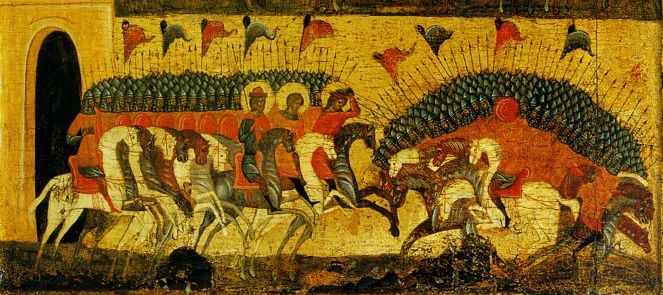
After Vsevolod Mstislavich was forced out of Pereyaslavl, he returned to Novgorod. In 1135 he was joined by his brother Izyaslav Mstislavich who had lost all his former principalities. With a Novgorod army the two Mstislavichy brothers marched against their enemy Yuri Dolgoruky. Novgorod, although rich in trade, fully depended on Rostov-Suzdal for bread and was hit hard by the inflated prices charged by Rostov-Suzdal. The Novgorod and Rostov-Suzdal armies met at Zhdanaya Gora, and despite the great loss of life, there was no decisive victory and Vsevolod Mstislavich was said to have fled the battlefield. Finally a compromise was reached in 1135 to end this conflict. The youngest Monomakhovich brother - Prince Andrey Vladimirovich of Volynia - was given Pereyaslavl and his former territory was given to Izyaslav Mstislavich in exchange.
Rise of the Novgorod Republic
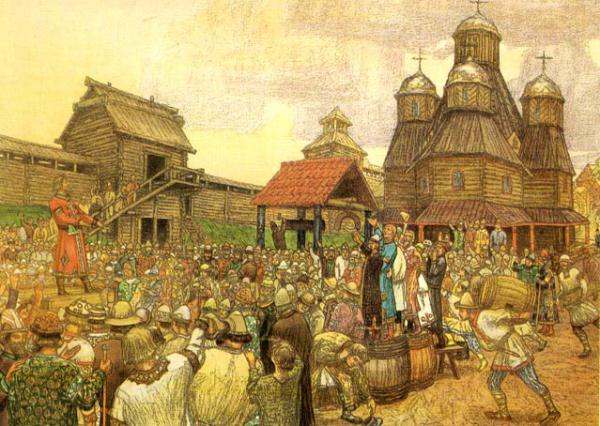
When Yaropolk II made Mstislav the Great’s son Prince Vsevolod Mstislavich of Novgorod prince of Pereyaslavl, he not only displeased the Monomakhovichy, but also the people of Novgorod. The local assembly of Novgorod (known as a ‘veche’) had, since the reign of Yaroslav the Wise, enjoyed certain extra privileges and they did not take kindly to being abandoned by their prince for another city. The poor showing at the Battle at Zhdanaya Gora was the final straw for the Novgorodians. They arrested their prince and then sent him from the city. The Novgorodian veche had recognised the rising influence of the Olgovichy branch of princes, who had benefitted from the hostility between the Mstislavichy and Monomakhovichy. They invited Svyatoslav Olgovich to be their new prince. Vsevolod Mstislavich attempted to return to the city, but was unsuccessful. Instead he settled in Novgorod’s sister city of Pskov, where he died in 1138. Ever since 1136 the Novgorodians showed great independence in selecting their princes and frequently expelled princes who did not meet their expectations, Svyatoslav Olgovich was expelled in 1138 when Novgorod attempted to make peace with Rostov-Suzdal. The richness of the principality meant that the various Ryurikid branches saw the importance of installing one of their own in Novgorod.
The Olgovichy in Power
After the death of Yaropolk II in 1139, he was succeeded by his brother Vyacheslav (Vyacheslav I), who was previously prince of Turov. However Prince Vsevolod Olgovich of Chernigov, son of Oleg Goreslavich, continued in his father’s pursuit for the Kievan throne and saw better success. Vsevolod had no problem in ousting Vyacheslav I and installing himself as grand prince (Vsevolod II). This mirrored the success he had in 1127 when he ousted his uncle Yaroslav Svyatoslavich from Chernigov. Mstsislav the Great who was grand prince at the time, allowed Vsevolod to take Chernigov upon being granted Kursk and some other territory from Vsevolod. Vsevolod was married to Mstislav the Great’s daughter Maria which also must have helped. Yaroslav Svyatoslavich had no choice but to be content with the land left for him from the Chernigov Principality – that of Murom-Ryazan, which later divided into Murom and Ryazan.
Vsevolod II understood the significance of Novgorod and attempted to reassert his influence over the important trading city. His chance came when the Novgorodians refused to follow their prince Rostislav Yurievich – the son of Prince Yuri Dolgoruky of Rostov-Suzdal – on a campaign against Vsevolod II and ousted him. Vsevolod II sent his brother Svytaoslav Olgovich back to Novgorod, but the Novgorodians wanted Vsevolod II’s son Svyatoslav Vsevolodovich not his brother. Vsevolod II agreed, but Svyatoslav Olgovich left Novgorod before his nephew arrived, meaning that Svyatoslav Vsevolodovich could not take up his place as prince of Novgorod. Instead Vsevolod II had to settle with a Mstislavichy representative in Novgorod, which at any rate was better than a Monomakhovichy representative. In 1142 Vsevolod II’s brother-in-law Svyatopolk Mstislavich became prince of Novgorod at the suggestion of Izyaslav Mstislavich – the most senior representative of the Mstislavichy branch.
Reign of Izyaslav II and the Struggle for Kiev
Vsevolod II died in 1146 and left his throne to his younger brother Igor, however the Kievans had had enough of the Olgovichy. They ousted Igor and instead invited Izyaslav Mstislavich, the oldest surviving son of Mstislav the Great, to rule as grand prince. Izyaslav II was an able leader and had the potential to become as great as his father and grandfather if it wasn’t for the continuous internecine warfare throughout his reign which involved almost all Rus principalities. Immediately after becoming grand prince, Izyaslav II met the two surviving Olgovichy brothers – the former Igor II and Svyatoslav Olgovich of Novgorod-Seversky – and their cousins the Davydovichy – Prince Vladimir Davydovich of Chernigov and his brother Izyaslav Davydovich – in battle. Izyaslav II was victorious and Igor Olgovich (Igor II) was captured after hiding out in a swap for several days. It seems the time of the Olgovichy had ended and the branch split with the Davydovichy branch switching sides to Izyaslav II.
Svyatoslav Olgovich though turned to Izyaslav II’s strongest opponent - Prince Yuri Dolgoruky of Rostov-Suzdal. After several years of conflict Izyaslav took the battle to Dolgoruky's land and ravaged Rostov-Suzdal in 1149. Yuri then demonstrated his long arms and marched on Pereyaslavl. Dolgoruky was victorious. He captured Pereyaslavl and then Kiev, as the citizens of both cities were reluctant to fight against a son of Vladimir Monomakh. Dolgoruky immediately installed his allies and children in various principalities, however he overlooked his elder brother Vyacheslav. At first Dolgoruky considered giving Vyacheslav the Kievan throne which was rightfully his, but changed his mind upon the Kievans' advice, saying that Vyacheslav would be unable to secure this position. The throne was indeed at risk and even Dolgoruky briefly lost his Kievan throne in 1150 as Izyaslav II returned and recaptured the city with the help of the Chernye Klobuki - Turkic people who had settled outside Kiev. Dolgoruky regained it with the aid of his powerful ally of Prince Vladimirko Voldarevich of Galich, who had managed to unite all Galician lands in 1144 upon the death of his brothers and the exile of his nephew Ivan Berladnik.
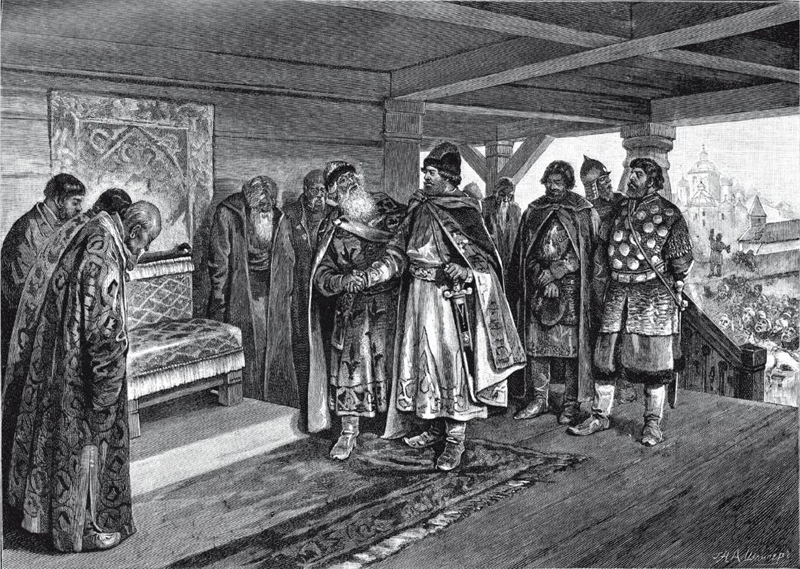
Izyaslav II returned in 1151 with the aid of Hungarian troops, sent by King Géza II of Hungary, who was married to Izyaslav II's sister Yevfrosinya Mstislavna. This time Izyaslav II had a new tactic for keeping hold of the Kievan throne - he invited his uncle Vyacheslav Vladimirovich (Vyacheslav I), the most senior prince, to be his co-ruler. Vyacheslav eventually agreed and ruled once more as grand prince of Kiev, but only in name; Izyaslav II held the real power.
Dolgoruky did not give up his attempts to rule in Kiev but the opportunity only returned in 1154 when Izyaslav II died. Vyacheslav I knew he was no match for his brother and so invited Izyaslav II's brother, Prince Rostislav Mstislavich of Smolensk, to be his co-ruler. Full scale war once against broke out in Rus. When Rostislav Mstislavich heard news that Vyacheslav I had died and that Dolgoruky was marching on Smolensk, he decided to make peace with Dolgoruky and give up Kiev to him. In 1155 Dolgoruky returned to Kiev a third and final time and ruled there until his sudden death in 1157. Many suspect that Dolgoruky was poisoned by Kievan boyars who had no love for the prince from afar who meddled so much in Kievan affairs.
Development of North-East Rus
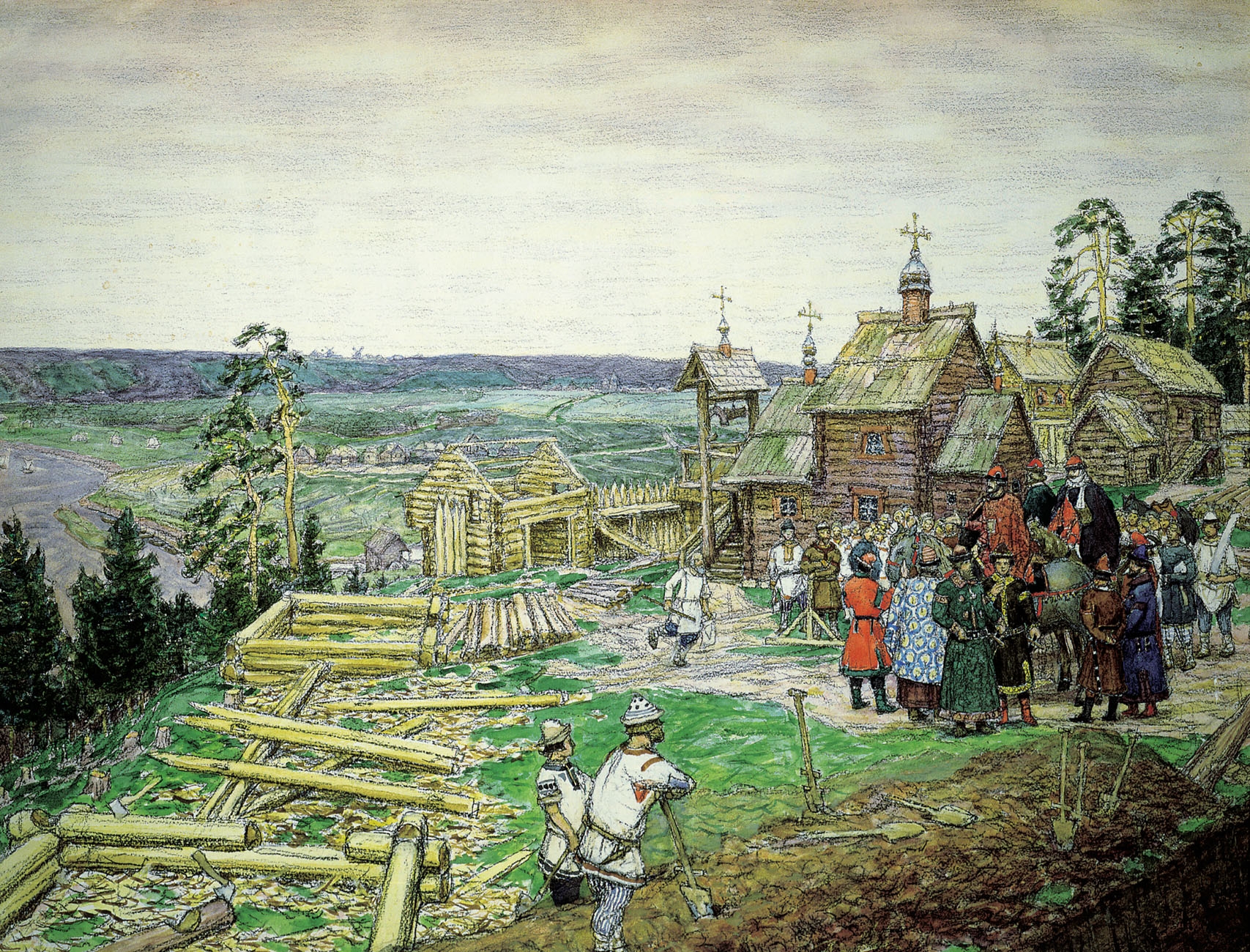
While Dolgoruky was pursuing his interests in Kiev, he did not neglect his base in Rostov-Suzdal. He is especially famous for founding new cities, most famously there is a story of how Dolgoruky confiscated an estate from one of his boyars (a noble) called Stepan Kuchko and built a new wooden fortress there. Kuchko was executed and his daughter Ulita was married to Dolgoruky's son Andrey (later known as Bogolyubsky). Kuchko's son entered Dolgoruky's service. The estate stood on the River Moskva, a tributary of the Oka, and was soon renamed Moskva after the river - it is better known in English as Moscow. Moscow was first mentioned in 1147 when Dolgoruky invited his ally Svyatoslav Vsevolodovich there for talks and this year is now taken as the official year of foundation of the Russian capital. In addition to Moscow, Dolgoruky is also credited with founding Dmitrov, Dubna, Ksnyatin, Pereslavl-Zalessky, Kostroma, and Gorodets. It is also possible that he founded the important city of Tver too.
Andrey Bogolyubsky and the Our Lady of Vladimir Icon
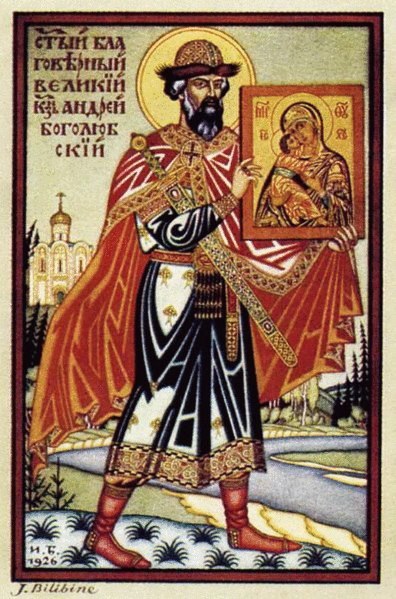
When Dolgoruky became grand prince of Kiev, he installed his son Andrey Yurievich in nearby Vyshgorod – a sign that Andrey would be his father’s heir. In 1155 though Andrey had had enough of Vyshgorod and returned to Vladimir in his father's Rostov-Suzdal Principality. Andrey had brought with him from Vyshgorod a revered icon of the Virgin Mary, which was said to have been painted by St Luke and was given by the Byzantine patriarch to Yuri Dolgoruky in 1131. Andrey originally intended to place the icon in Rostov but according to legend, while resting on route, Andrey saw in a vision the Virgin Mary who told him to found a church here at the site of the appearance and also to place the Vyshgorod Icon in Vladimir where a cathedral should be built for it. Andrey turned back to Vladimir and did has he was instructed. He began the construction of the Dormition Cathedral in Vladimir and placed the icon there. It eventually became known as the Our Lady of Vladimir Icon and today it remains one of Russia's most sacred relics. At the site of the appearance of the Virgin Mary, Bogolyubovo was founded which served as Andrey’s new residence. The name Bogolyubovo is formed from the Russian word for god 'bog' and love 'lyubov' - and Andrey himself became known in history as Andrey Bogolyubsky. After Yuri Dolgoruky's death in 1157 Andrey Yurievich Bogolyubsky became prince of Rostov-Suzdal but instantly moved the capital of the principality to Vladimir and the principality became known as the Vladimir Principality.
The Sack of Kiev and Rise of Vladimir
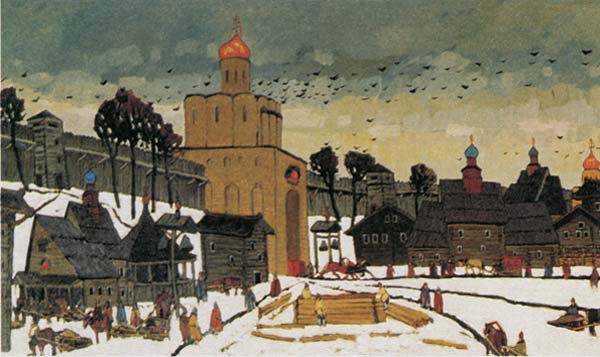
In 1169 Andrey Bogolyubsky decided to follow in the footsteps of his father and demonstrate that his arms too were long enough to get involved in Kievan affairs. He organised a large campaign which was headed by his son Mstislav Andreevich. The coalition began besieging Kiev which was then ruled by Grand Prince Mstislav II (the son of Izyaslav II and the grandson of Mstislav the Great). Mstislav II’s allies failed to show up to liberate the city and Kiev fell. For two days the armies of the coalition looted the city. Many of its citizens, including monks, were enslaved and its monasteries, cathedrals and churches were robbed of their gold icons and other relics. Bogolyubsky had won Kiev but he did not become grand prince of Kiev, instead he installed his brother Gleb Yurievich in Kiev. Bogolyubsky had other plans. Not wanting to be grand prince of Kiev, he named himself grand prince of Vladimir and created the Vladimir Grand Principality. The centre of Rus was shifted from Kiev to the north-eastern city of Vladimir and the core of modern-day Russia came into being. Bogolyubsky intended to make his city of Vladimir a true rival of Kiev. The centre piece was the Dormition Cathedral and he also had the city surrounded by walls including the Golden Gates. Bogolyubsky also founded a monastery and the surviving Intercession Church on the Nerl in Bogolyubovo. Not content with having the most revered relic in Vladimir, he also wanted Vladimir to have its own metropolitan. However the patriarch in Constantinople refused Bogolyubsky’s request and the bishop of Rostov remained subordinate to the metropolitan of Kiev.
Murder of Andrey Bogolyubsky
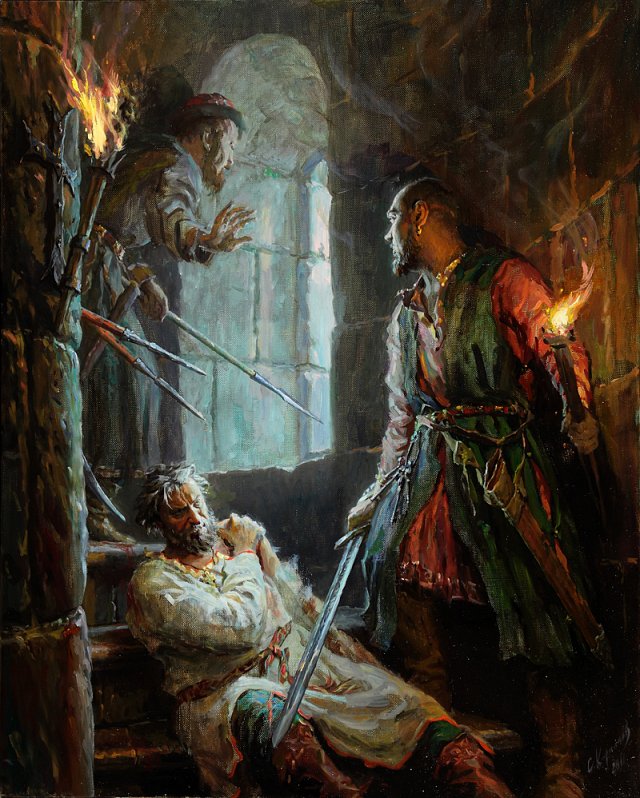
Andrey Bogolyubsky was popular among the common people, but he had made many enemies among the boyars, especially in Suzdal and Rostov who saw their ancient cities being side-lined by the upstart of Vladimir. In 1174 Bogolyubsky was murdered in his residence in Bogolyubovo during a boyar plot, led by his brother-in-law - Yakim Kuchko. The group of conspirators entered his bed chamber, having previously removed his sword. Bogolyubsky was a strong man and managed even to kill one of the conspirators, but the numbers were against him. The conspirators even almost failed in their mission when Bogolyubsky, who had been left for dead, got up and started escaping down the stairs. He was finally finished off on the stairs of his residence.
The Struggle for Dominance in North-West Rus
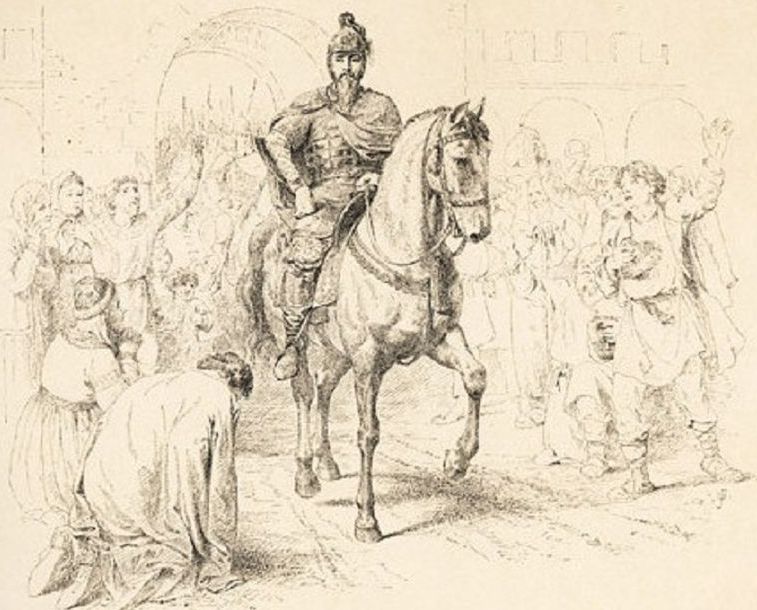
As was the case for Kievan affairs, the same became true for ascending to the Vladimir throne and Andrey Bogolyubsky's murder was followed by an internecine war. The two main factions were Bogolyubsky's nephews - Mstislav Rostislavich and Yaropolk Rostislavich, the sons of his elder brother Rostislavich, known as the Rostislavichy - and Bogolyubsky's younger brothers - Mikhail Yurievich and Vsevolod Yurievich, who were jointly known as the Yurievichy. Bogolyubsky was immediately succeeded in Vladimir by his younger brother Mikhail Yurievich, but the boyars of Suzdal and Rostov had a preference for the Rostislavichy brothers and invited them to rule in Vladimir. The resulting hostility forced Mikhail to flee to Chernigov in the same year and Mstislav Rostislavich became grand prince. However Mstislav Rostislavich based himself in Suzdal, whereas his brother Yaropolk went to Rostov. In 1175 Mikhail Yurievich was able to return to Vladimir and this time Suzdal and Rostov also recognised him as grand prince, but in 1176 Mikhail promptly went and died. Mikhail was succeeded by his brother Vsevolod Yurievich (later known as the Big Nest) and Mstislav and Yaropolk were defeated in battle at the River Lipitsa near Yuriev-Polsky in 1176.
The Rostislavichy brothers fled to Ryazan where their brother-in-law Gleb Rostislavich was grand prince. This lead to Vsevolod leading an army, supported by his Chernigov and Pereyaslavl allies, against the Ryazan Principality. The armies met near the River Kokoshka in 1177. Vsevolod was once again successful and Mstislav Rostislavich, Gleb Rostislavich of Ryazan and his son Roman Glebovich and other Ryazan nobles were taken back to Vladimir as prisoners. Yaropolk Rostislavich was also later captured and sent to Vladimir. The two Rostislavichy brothers were blinded, although it is believed they were just cut above the eyes, which were not actually removed. In any case Yaropolk's sight is said to have miraculously returned later while praying at a monastery in Smolensk. Mstislav died in 1178. Gleb Rostislavich of Ryazan also died in 1178 in prison, after refusing an offer to be released on condition than he exiled himself to south Rus. Vsevolod's reign in Vladimir was finally secured.
The Big Nest
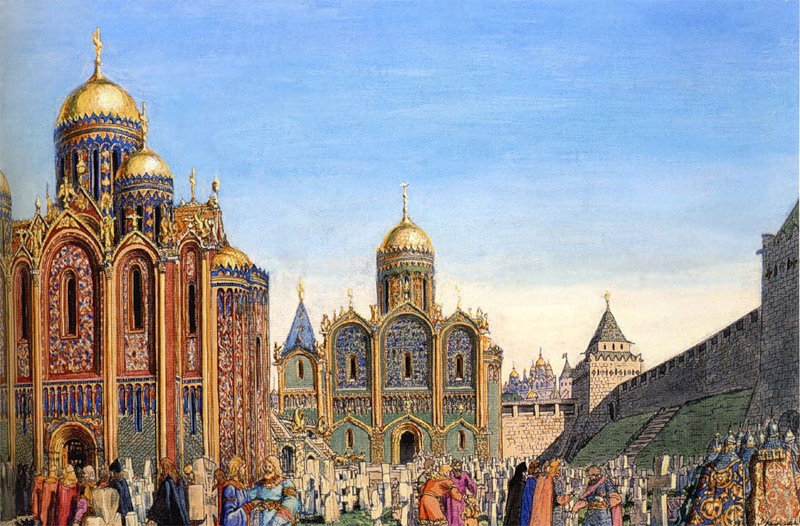
Grand Prince Vsevolod of Vladimir has become known in history as Vsevolod the Big Nest as he had at least twelve children, of which four sons became grand prince. During Vsevolod the Big Nest's reign from 1176 to 1212, which is extraordinarily long for Rus leaders, the Vladimir Grand Principality strengthened its position as the leading Rus principality as the cities founded by Vsevolod's father Yuri Dolgoruky grew in importance. Vsevolod left his mark on the capital in the form of the beautiful St Demetrius' Cathedral which was completed around 1197. His wife Maria Shvarnovna founded the Uspensky Knyaginin Convent in the city. Vsevolod managed to secure Novgorod by installing puppet rulers there and led successful campaigns against the Polovtsians and Volga Bulgaria.



